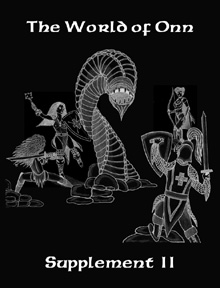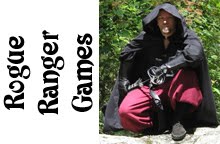Session 2 began with our adventurers meeting outside Cicero's Books in order to explore the Undercity for a bit. They entered and talked with Cicero (who made Flambo go around back for fear he would topple the many shelves and stacks of books). Once they secured Cicero’s permission, he let Flambo in the back door and allowed them access to his cellar, where a hole in the wall allowed access to the Undercity.
The first chamber was large and had a few discarded items from a previous adventuring party, such as damaged shields, broken weapons and many blood stains, some of which were drag marks leading through a northern doorway (now closed). A passageway also exited to the chamber’s east, but they boldly chose the door. Vendee forced it open, but creatures were waiting on the other side and surprised the group, pelting them with sling fire. Missile combat ensued with Daniel and Flambo taking some minor wounds, but in the end, half a dozen headless creatures were slain (one fumbled his attack and killed himself). The last one tried to escape, but as he ran Indiana Jones-style over the bodies of his comrades, Flambo’s sling found its mark and took it out. The group examined them and determined to save a couple of bodies for the town’s sage and any other interested buyers and pocketed some coin as well.
The exits from here were a door to the north that was heavily barred, boarded and chained and a passageway heading east. Galeena got ‘volunteered’ to scout ahead and came back a short while later reporting another headless creature was tending to five giant rats in pens. Quietly she led them to the room and with surprise showered the thing with missile fire, killing him before he knew what happened. The rats were dispatched in quick fashion in their pens and a quick search turned up nothing of interest or value. Flambo did notice rat saddles, keeping one for any interested buyer of odd things.
The only other exit from the room was a passage to the north, which was an empty room with a passage leading to the west. Before the group made half way through the room though, the splintering of wood was heard from the western passage and 5 green-eyed skeletons made their way into the room.
Vendee, brandishing a ‘magical’ amulet Flambo bought for him in the market, discovered its powers worked and the undead ignored him utterly, focusing on the rest of the group. The fight went bad quickly with the skeletons knocking Lirus and Galeena unconscious early (but Flambo woke Lirus back up quickly) and then Daniel was skewered and Flambo took a couple of hits (going unconscious but remaining stable). The undead realized that there was another attacker they couldn’t see when they finally started dropping to Vendee’s attacks, but eventually he overcame them with an enlargement spell from Lirus. Wounded and bereft of their cleric’s aid, they drug the dead and wounded back to Cicero’s cellar and up into the back room. Vendee stayed with them and sent Lirus to fetch a cleric from the city’s temple. When they returned, the cleric healed Galeena quickly, but had qualms about healing Flambo since he worshipped the God of Fire and he was a cleric of the Goddess of Water. A few coins loosened his morals though and Flambo was healed back to consciousness and given a good scare when his first sight was a holy symbol of Oceanus.
They took Daniel’s body to the Temple of the Waves for Last Rites, leaving him with the clerics along with a silver piece for the Ferryman to ensure his spirit made it to the proper place. Then they visited the sage Suelomon to learn more about the headless creatures (they learnt most people just called them ‘Things’) and on his suggestion visited Wynter’s Oddities, a place for strange items and wonders. They showed a headless body (along with authentic headless spear and sling with rocks!) and rat saddle to one of the curators and took an offer of 60 gold for them.
At this point they decided to celebrate their fallen comrade by having a toast in his name. Going to the Blue Boar, they discovered a packed house and adventurers were all about. Eventually they met with the group heading to Haindrad’s Hills (including 2 elves, 2 dwarves, 1 gnome and a bunch of humans) to explore for the location of Haindrad’s Tomb. They hired on for a regular share and were told to meet at the north gate at mid-morning the next day.
Most of the first three days of caravan guard duty were uneventful, but on the 2nd day the elven druid grew uneasy, citing the weather and nature weren’t feeling right. On the third day, a funnel exploded downwards from the sky, sucking one of the three wagons and the two dwarves away and almost Galeena with them if not for Flambo’s quick thinking and grabbing her. After a few minutes the event ended as quickly as it started. The elven druid called it a Shieldstorm when Flambo asked what happened and explained that when the layer surrounding the world is torn open, a vortex forms under it sucking out everything nearby into the space beyond before it naturally repairs itself. In his time as a druid, the elf has only seen the event twice so they are rare.
On the fourth day, one of the human guards was gone, just a sword and blood smear on the ground where he was keeping watch. No one heard or saw anything…
The fifth day the explorers were within sight of the hills and the gnome (now the leader since the dwarves were presumed dead) broke out the brandy bottles to celebrate. He explained that there were other groups planning similar expeditions, but they are the first to reach the hills. Potent stuff, most of the expedition was passed out by late evening. In the morning of the 6th day, Vendee suggested to the gnome that they at least enter the hills before any more celebrating, which the gnome begrudgingly agreed to (and the rest of the expedition grumbled through epic hangovers packing camp up and traveling the day to get into the hills).
Setting up a base camp, the gnome produced a map with seven locations marked, four of which were “X” over. He explained these were failed expeditions he already undertook. The elven druid can sense when something is amiss with the natural surroundings so these locations were indeed places with something odd or wrong with them, but not Haindrad’s Tomb. He decided that the nearest location, marked “B” would be a good place to start and packed up a wagon, leaving 2 guards and a wagon to remain at base camp.
The next day they explored the new location and Vendee found an odd chunk of obsidian with a red dot in the center of one of its sides ( a sign of Apathos, Haindrad’s Patron Deity) and exploration of the area turned up a set of massive stone doors buried under the soil. Unearthing them and getting them open after a few hours of labor, the gnome decided to enter first and immediately set off a trap, fatally burning himself and a human guardsman. Galeena was ‘volunteered’ to scout again and descended the stairs. When the others joined her, they saw an awesome sight - the structure wasn’t Haindrad’s Tomb, but the tomb of the Zuhn Empire’s 114th Mekanized Legion. The Legion’s motto was carved in Ancient Common (Zuhn) round their symbol on the ceiling and a crumbling war mek stood in the center of the room. Around the room were pillars and alcoves, each containing a suit of ancient armor. Two suits animated and moved to a guard position in front of the mek, one of them flatly explaining that desecrators of the tomb would be put to death. Flambo apologized and the group backed out of the tomb, not wanting to risk more of the armor animating or the war mek itself. Despite Galeena’s pleas to attempt exploration, the tomb was resealed (but noted on their map).
Still early in the day, they made for site “A”, only a couple of hours away from their current location. When they arrived, they eventually found another obsidian stone with a red dot and unburied an ancient Zuhn-styled archway with three pillars. They fiddled with it for some time, causing it to weakly pulse when they moved through it, but nothing seemed to happen. Flambo cast detect Magic and did feel a very weak field, but determined that whatever magics it once possessed has faded over the millennia to a point where they are useless. Resolving that site “C” is their best chance left, the group returned to base camp and determined to make a fresh start the next day. They expected something bad to have happened to the humans after the trip so far, but on their return learnt that the humans were alive and well but did have a scare with a giant lizard that got bored and left after examining them. Bedding down for the night, things passed quickly.
The next morning they awoke to a slimy, human-faced worm creature attacking one of the guards. Vendee rolled out of his bedroll and came up firing his bow, striking true and killing the creature on a single shot. Four more of the worms reared up though and tore the guard into shreds. The party managed to kill two more and the last two disappeared with puffs of acrid smoke.
Getting their gear and packing up base camp, they back-trailed the slime trails to the magical archway. Deciding it was an oddity to be studied at some later date, they filled it with stones and reburied it, then set out for the last location on the map with what was left of the day…
End of session 2…
Campaign Date:
Solenus 5th-13th, 5231 A.C.
XP given out:
Flambo the Acolyte - 710 xp (785 xp)
Vendee the Magi-scout - 822 xp (934 xp)
Galeena Bramblefoot, Woman-at-Arms - 355 xp (355 xp)
Lirus the Prestidigitator - 355 xp (355 xp)




